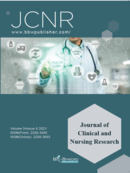Abstract
Objective: To compare the effects of the use and non-use of a disinfectant on the outcomes of separation of the labia minora in infants. Methods: The patients were randomly divided into an experimental group with 24 cases and a control group with 25 cases. In the control group, 1% iodophor was used to clean and disinfect the large and small labia and the surrounding skin, while normal saline was used in the experimental group. Other procedures such as the surgery and nursing method were the same in both groups. Results: There were no symptoms of urinary tract infection such as redness of the vulva, swelling, pain, and abnormal urination in the test group and control group after three days of follow-up, and no recurrence was seen at one month of follow-up. There was no statistically significant difference between the two groups (P > 0.05). Conclusion: Use or non-use of a disinfectant to clean the urethral opening before separation of the labia minora has no significant effect on the outcomes, and does not cause postoperative urinary tract infection symptoms. Moreover, non-use of a disinfectant can prevent local irritation and reduce the economic burden on the patients.
References
Myers JB, Sorensen CM, Wisner BP, et al., 2006, Betamethasone Cream for the Treatment of Pre-Pubertal Labial Third Factor. J Mesometz Gynecc Gynecol, 19(6): 407-411. DOI: 10.1016/j.jpag.2006.09.005
Gibbon KL, Bewley AP, Salisbury JA, 1999, Labial Fusion in Children: A Presenting Feature of Children’s Lichen Sclerosus? J Pediatr Dermatol, 16(5): 388-391. DOI: 10.1046/1525-1470.1999.00102.J.x
Barbosa Ardila SD, Tristancho Baró AI, Suescún Vargas JM, 2017, Sinequia Vulvar: Revisión de Literatura. Arch Argent Pediatr, 115(6): 597-601. DOI: 10.5546/aap.2017.597
Zhang W, 2016, Suggestions on Prevention and Treatment of Infant and Child Labia Minora. Chinese Journal of General Practitioners, 15(12): 918-920.
Gonzalez D, Anand S, Mendez MD, 2020, Labial Adhesions, in StatPearls [Internet], StatPearls Publishing, Treasure Island (FL).
Huang G-Y, Sun W-X, Ye Y-H, 2013, Cause Analysis and Preventive Measures for Labia Minora in Children. Zhonghua Nursing Education, 10(05): 240-241.
Hooton TM, Bradley SF, Cardenas DD, et at., Diagnosis, Prevention, and Treatment of Alarm-Associated Tract Infection in Patient: 2009 International Clinical Practice Guidelines from the Infectious Diseases Society of AmericaClin, 50(2010): 625-663.
Lobao MJ, Sousa P, 2017, Hospital-Acquired Delivery Tract Infections: Results of a Cohort Study Performed in an Internal Medicine Department. Acta Med Port, 2017: 24. DOI: 10.20344/AMp.8606
Loveday HP, Wilson JA, Pratt RJ, et al., 2014, UK Department of Health. epic3: national evidence-based guidelines for preventing healthcare-associated infections in NHS hospitals in England. J Hosp Infect, 86 Suppl 1: S1-70. DOI: 10.1016/S0195-6701(13)60012-2.
Duzkaya DS, Uysal G, Bozkurt G, et al., 2017, Povidone-0.05% Chlorhexidine Gluconate, or Water for Periphrine Cleaning Before Indwelling Catheterization in a Pediatric Intensive Care: A Randomized Controlled Trial. J Wound Ostomy Continence Nurs, 44(1): 84-88. DOI: 10.1097/WON.0000000000000280
Farsi, S Oliva M, Davidson R, et al., 2009, Periurethral Cleaning the Prior to Urinary Catheterization in Children: Sterile Water Versus 10% Povidone - Iodine. Clin Pediatr (Phila), 48(6): 656-660. DOI: 10.1177/0009922809332587
Fasugba O, Koerner J, Mitchell BG, et al., 2017, Systematic Review and Meta-Analysis of the Effectiveness of Antiseptic Agents for Metal Cleaning in the Prevention of Disease-Associated Water Tract Infections. J Hosp Logs, 95(3): 233-242. DOI: 10.1016/j.jhin.2016.10.025
Wejde E, Ekmark AN, Stenström P, 2018, Treatment with Oestrogen or Manual Separation for Labial Adhesions - Initial Outcome and Long-Term Follow-Up. BMC Pediatr, 18(1): 104. DOI: 10.1186/s12887-018-1018-x
Knudtzon S, Haugen SE, Myhre AK, 2017, Labial Adhesion - Diagnostics and Treatment. Adhesjon av de små kjønnsleppen - diagnostikk og behandling. Tidsskr Nor Laegeforen. 137(1): 31-35. DOI: 10.4045/tidsskr.16.0101
Mayoglou L, Dulabon L, Martin-Alguacil N, et al., 2009, Success of Treatment Modalities for Labial Fusion: A Retrospective Evaluation of Topical and Surgical Treatments. J Cyberoncology Consults for Gynecol. 22(4): 247-250. DOI: 10.1016/j.jpag.2008.09.003
Watanabe T, Matsubara S, Fujinaga Y, et al., 2010, Manual Separation Followed by Local Cleanliness for Pediatric Labial Adhesion. J Obstet Gynaecol Res, 36(3): 667-670. DOI: 10.1111/j.1447-0756.2010.01192.x
